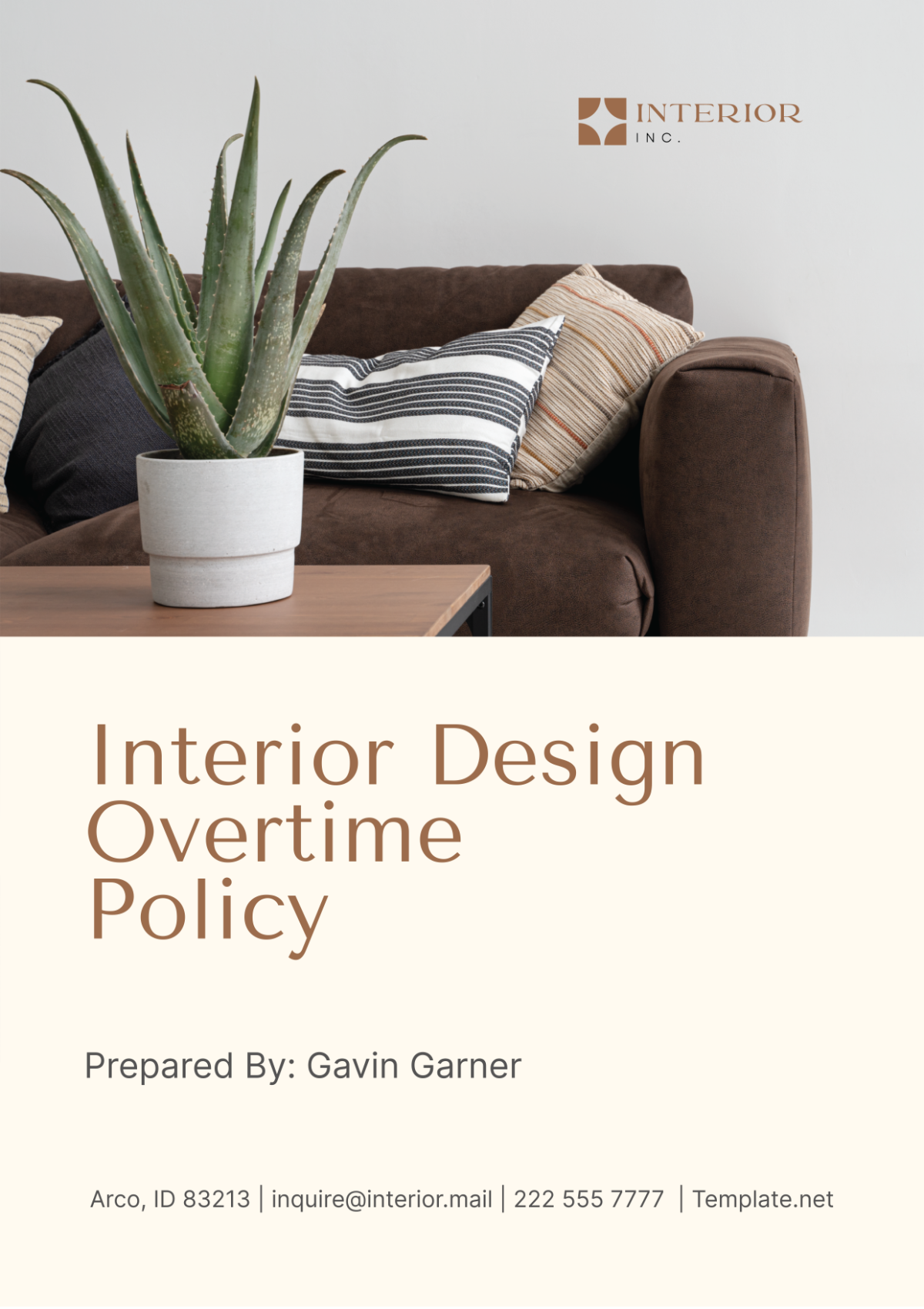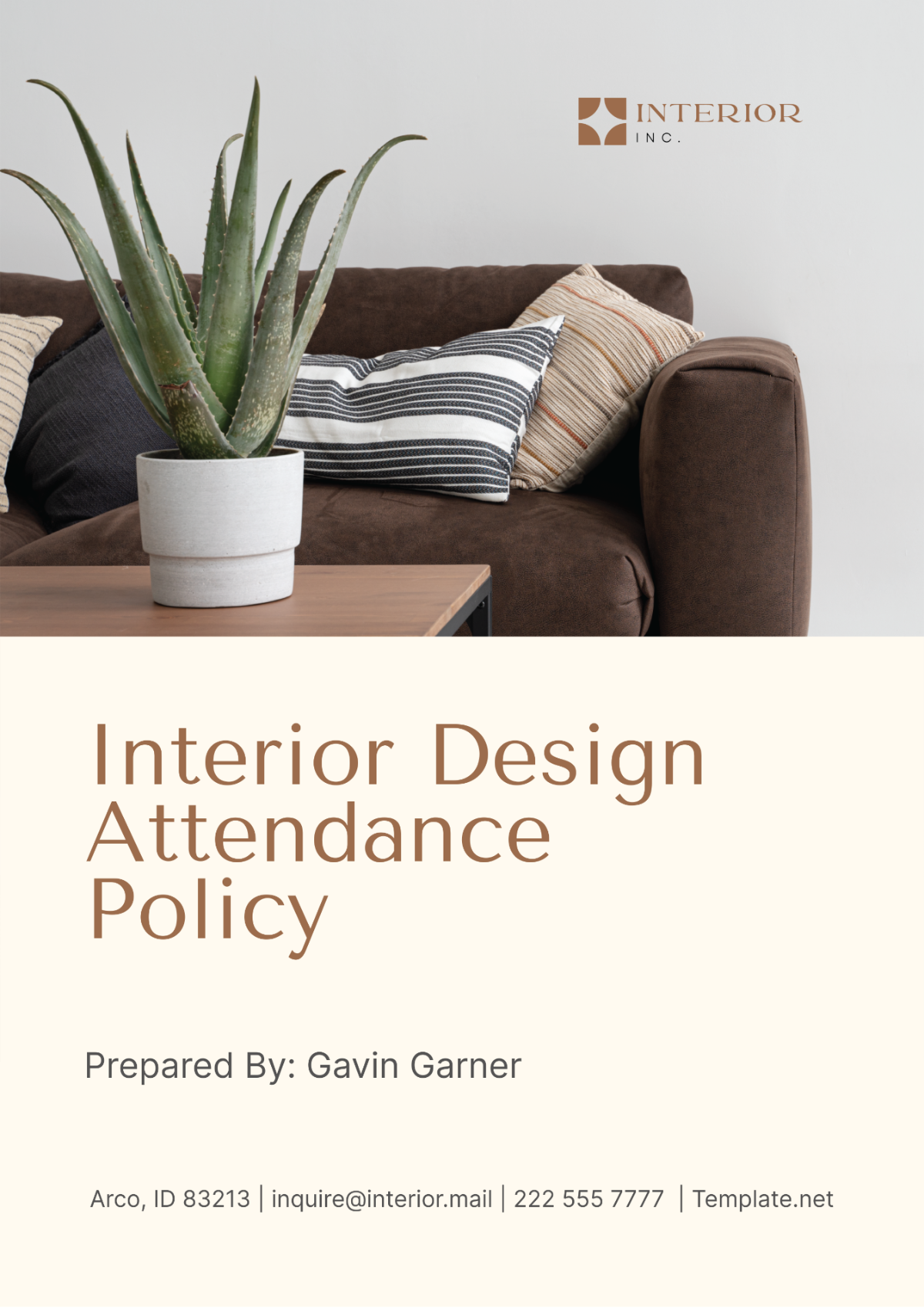Free Interior Design Overtime Policy

- 100% Customizable, free editor
- Access 1 Million+ Templates, photo’s & graphics
- Download or share as a template
- Click and replace photos, graphics, text, backgrounds
- Resize, crop, AI write & more
- Access advanced editor
Ensure fair and transparent practices in your interior design firm with Template.net's Interior Design Overtime Policy Template. Tailored for clarity and compliance, this template delineates guidelines for overtime work, fostering a balanced work environment. Customize effortlessly using our AI editor tool, adapting the policy to align with your company's values and regulations. Promote productivity and well-being with Template.net's expertly crafted solutions.
You may also like
- HR Policy
- Restaurant Policy
- Company Policy
- Accounting Policies and Procedures
- Website Policy
- Privacy Policy
- Safety Policy
- School Policy
- IT and Software Policy
- Law Firm Policy
- Construction Policy
- Interior Design Policy
- Travel Agency Policy
- Education Academic Policy
- Security Policy
- Real Estate Policy
- Expense Policy
- Software Policy
Effective Date: January 1, 2050
Introduction
At [YOUR COMPANY NAME], we recognize that our employees are our greatest asset, and their dedication is crucial to our success. This Overtime Policy is designed to ensure fair compensation for additional hours worked while supporting the operational needs of our projects. It balances the demands of our dynamic work environment with the well-being of our team, ensuring that overtime is managed efficiently and ethically.
1. Purpose
This policy outlines the rules and provisions related to overtime work, aimed at ensuring fair compensation and promoting a healthy work-life balance. It is crafted to provide clarity and consistency in how overtime is authorized, calculated, and compensated. The policy supports [YOUR COMPANY NAME]'s commitment to complying with the Federal Labor Standards Act (FLSA) and applicable state labor laws, thereby safeguarding our employees' rights while aligning with our organizational goals.
2. Scope
This policy applies to all employees within the Interior Design Department of [YOUR COMPANY NAME] who are classified as non-exempt under the FLSA and relevant state labor laws. It encompasses various employment types, including full-time, part-time, and temporary employees, ensuring that all personnel engaged in our projects are covered under these guidelines.
3. Policy Statement
[YOUR COMPANY NAME] firmly believes in compensating employees fairly for additional hours worked beyond their regular scheduled hours. We consider overtime to be an exception, utilized only when necessary to meet critical project deadlines or to address unforeseen circumstances impacting project delivery. This policy provides the framework for managing such exceptions, ensuring that all overtime work is pre-approved and that employees are compensated according to legal and ethical standards.
4. Eligibility
All non-exempt employees are eligible for overtime compensation if they work more than 40 hours in a given workweek. This policy clarifies that overtime must be pre-approved and should only be utilized when necessary to meet project requirements or when unexpected work demands arise. Additionally, any exceptions to this eligibility, such as periods of employee probation or specific training phases, will be clearly noted and communicated to affected employees.
5. Overtime Authorization
5.1 Standard Overtime Approval
Overtime work must be formally pre-approved by either the project manager or the department supervisor. Employees are required to submit a written request or complete an Overtime Authorization Form at least 24 hours in advance of the anticipated overtime. This process includes the following steps:
Submission of Request: Employees must submit their request through a designated digital platform or by filling out a physical Overtime Authorization Form. This form should include the date, estimated hours, and the specific reason for the overtime.
Supervisory Review: The supervisor will review the request considering the project deadlines, current resource allocations, and the overall impact on budget and project delivery. This review is crucial to ensure that overtime is justified and aligns with project needs.
Communication of Decision: Approval or denial of the request, along with any modifications to the proposed hours, will be communicated to the employee in a timely manner. This ensures transparency and allows employees to plan accordingly.
5.2 Emergency Overtime
In situations where prior approval is not feasible due to urgent project needs, the following protocol will apply:
Retroactive Approval: Employees may proceed with necessary overtime work to address the immediate need but must report this overtime to their supervisor at the earliest opportunity, no later than the next working day.
Supervisory Confirmation: Supervisors will assess the situation post hoc to confirm the validity of the overtime work and ensure that it is recorded and compensated appropriately.
6. Overtime Compensation
Overtime work is compensated at a rate of one and a half times the regular hourly rate of the employee. This rate applies to all approved overtime hours that exceed the standard 40-hour workweek.
6.1 Payment Schedule
Overtime payments are processed with the regular payroll for the period during which the overtime work was performed. This ensures timely and accurate compensation for employees and simplifies administrative processes.
6.2 Special Rates
For work performed during holidays and weekends, a higher compensation rate of double the regular hourly rate may be applied. This special rate is designed to acknowledge the extra commitment required from employees during these periods. Employees will be informed in advance of any project phases that may require weekend or holiday work, and the associated compensation rates.
7. Overtime Limitations
[YOUR COMPANY NAME] places a cap of 12 hours of overtime per employee per week. This limitation is in place to protect employee health and ensure sustained productivity. It reflects our commitment to promoting a reasonable work-life balance.
7.1 Exceptions
In extraordinary circumstances, where project deliverables are at risk, this cap may be exceeded temporarily. Such exceptions must be approved by the senior management team and will be communicated clearly to the affected employees, along with details about additional support or compensatory measures that may be offered.
7.2 Monitoring and Adjustments
Regular reviews of overtime usage are conducted to ensure adherence to this policy and to assess the health and well-being of our staff. Adjustments will be made as necessary, based on these reviews, to prevent chronic over-reliance on overtime.
8. Recording Overtime Hours
Accurate recording of all worked hours, including overtime, is mandatory. The company provides a designated timekeeping system for this purpose.
8.1 Timekeeping System
Employees are required to log in and out of the timekeeping system, capturing the start and end times of their workdays, including any breaks taken. This system is audited regularly to ensure its accuracy and reliability.
8.2 Reporting Discrepancies
Employees must report any discrepancies in recorded time to their supervisor or the Human Resources department immediately. Timely reporting helps address any issues related to payment or hours worked without delay.
9. Non-Retaliation
[YOUR COMPANY NAME] adheres to a strict non-retaliation policy to protect employees who request or require overtime, in accordance with this policy and applicable laws.
9.1 Protection from Retaliation
Employees can report overtime concerns or complaints without fear of adverse consequences. Any reports of retaliation will be investigated promptly and thoroughly by the Human Resources department.
9.2 Encouragement of Reporting
Employees are encouraged to speak up about any instances of coercion or other related issues concerning overtime. This openness helps maintain a fair and respectful working environment.
10. Policy Review and Modification
This policy is reviewed annually or as necessary to respond to changes in labor laws or company operations. All modifications will be documented and communicated effectively to all employees to ensure continued compliance and understanding.
10.1 Involvement in Policy Updates
Employees are invited to contribute their insights during the review process. This inclusion helps ensure that the policy remains relevant and effective in meeting the needs of both the company and its employees.
10.2 Communication of Changes
Any changes to the policy will be communicated through email, staff meetings, and posted on the internal company website. Employees will have access to training sessions to fully understand any new policy implementations.
Contact Information
For further inquiries regarding this Overtime Policy, or if you require assistance or clarification on any aspect of these guidelines, please contact the Human Resources department at [YOUR COMPANY EMAIL]. We are dedicated to providing support and ensuring that all employees have the information they need to navigate the terms of their employment effectively.
Through these detailed expansions, the Interior Design Overtime Policy at [YOUR COMPANY NAME] aims to foster a transparent, fair, and supportive work environment that values the contributions of each employee while balancing the demands of the industry. This comprehensive approach ensures that the policy not only complies with legal standards but also supports the operational and personal needs of the workforce.





















